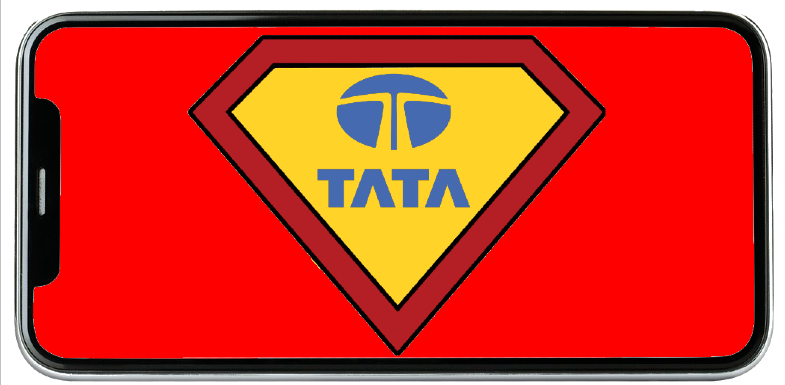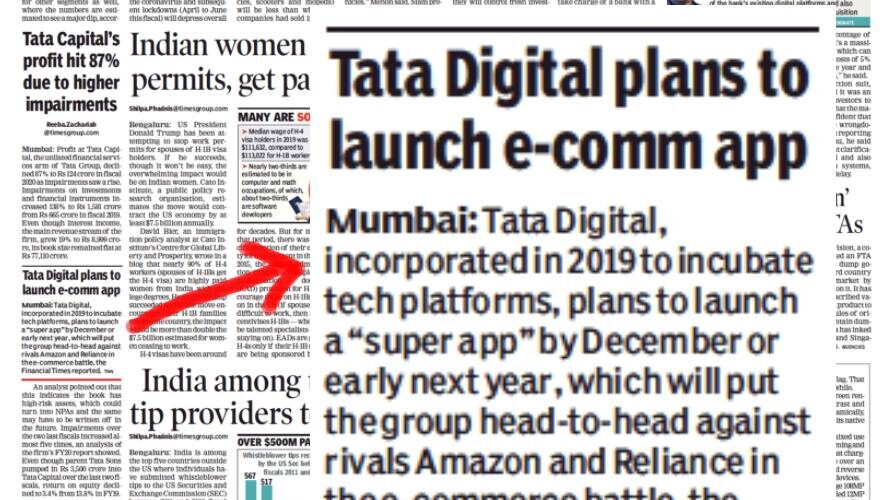
The Financial Times got a fantastic scoop yesterday.

It was a scoop that the Indian media had no clue about and even the mighty Times of India was forced to report it as a small box item with credit to FT. I’m sure they would have unleashed their team on Tata senior brass to ensure that there is at least one long-format story on it in a week or so.

The story itself is very interesting. The Tata Group is planning to launch a superapp by the end of this year, or early next year!
My first reaction was to check my phone if I have at least one app that belongs to, even remotely, the Tata Group. I have 147 apps. Not one is even indirectly connected to the Tata Group.
Now, that rudimentary point should in no way be construed as my cynicism of Tata Group’s intent or ambition. They are completely free to try and perhaps crack India’s first superapp.
Superapps are popular mainly in China, thanks to WeChat’s early start and success. Alipay, Grab and Gojek followed suit. (See related reading material at the end of this post)
The main point of a superapp is that it first needs a persistent user need as the focal point. WeChat had messaging at its core and it was a place that users lived in, digitally. Alipay had payments at its core and users used it multiple times through the day. There are lesser reasons for users to stay on Grab or Gojek, however.
But once you have a property that people compulsively use multiple times a day, then you have proven the utility value of that app. And because you have done that, it makes sense to nudge users to look at other, potentially related/beneficial services when their attention is focused on your app.
In the offline world, it is like getting a great location for a store and then stacking multiple kinds of products one after another in the same store.
Considering they do not have any serious play in any traction-showing app right now (would Tata Cliq pass the test?), Tata Group seems to be trying the opposite route – assemble everything first in the corner of a city (like Metro or Walmart) and then expect that combination to draw people in.
If you look at the Tata portfolio, the retail parts (groceries under Sampann/StarBazaar/StarQuik, fashion under Cliq, tea, Starbucks etc.) offer the strongest portfolio that can get users using the combined bouquet very often through the mobile phone.
Then come the next layer: the occasional buys – Titan, Tanishq, Vistara, Croma, Hotels (Taj/Ginger) and so on.
The 3rd layer would be even less frequent/annual buys – Housing, insurance, cars.
The Tata Group could also add several other layers through partnership – payment, messaging/chat, food delivery, ride-hailing etc. But partnerships are just that – not tightly integrated, but slapped on top to offer the illusion that there’s more than what one sees. That level of superapp-ing is already being attempted by payment-first companies like Paytm and PhonePe in India, with middling success.
What Tata was supposed to (ideally) bring in is the kind of tight integration where the users do not see or feel the silos, and see the front as one megastore where they can walk up and down, and bill in one place, and get out happily.
The bigger challenge is, of course, one around choice.
Why should someone install the Tata Group’s superapp?
Why should someone order groceries via this app instead of Amazon, Flipkart or Big Basket?
Why should someone book air tickets via this app instead of a travel aggregator that they are already used to?
Why should someone pay using the superapp when Google Pay or PhonePe is something they are already used to?
Why should someone book a cab using the superapp if they already have a better experience directly on the Uber app?
Amazon, for instance, answers the ‘why‘ with Prime. Is there an equivalent of Prime that Tata could work on, to incentivize (not merely monetarily, but also through other means) users to use the superapp?
Jio and Amazon seemed primed (pun unintended) to try the superapp game in India, but it is good to see a far older business behemoth throw the hat into the ring. While Jio has the money, Amazon has the on-ground creds, Tata does bring in tech. super-skills from their TCS brand. Would that, which already helps other biggies with digital transformation, transform Tata’s superapp into a compelling offering? I’m very curious to see how this works out.
Related reading:
1.
2. India’s most popular services are becoming super apps
3.
